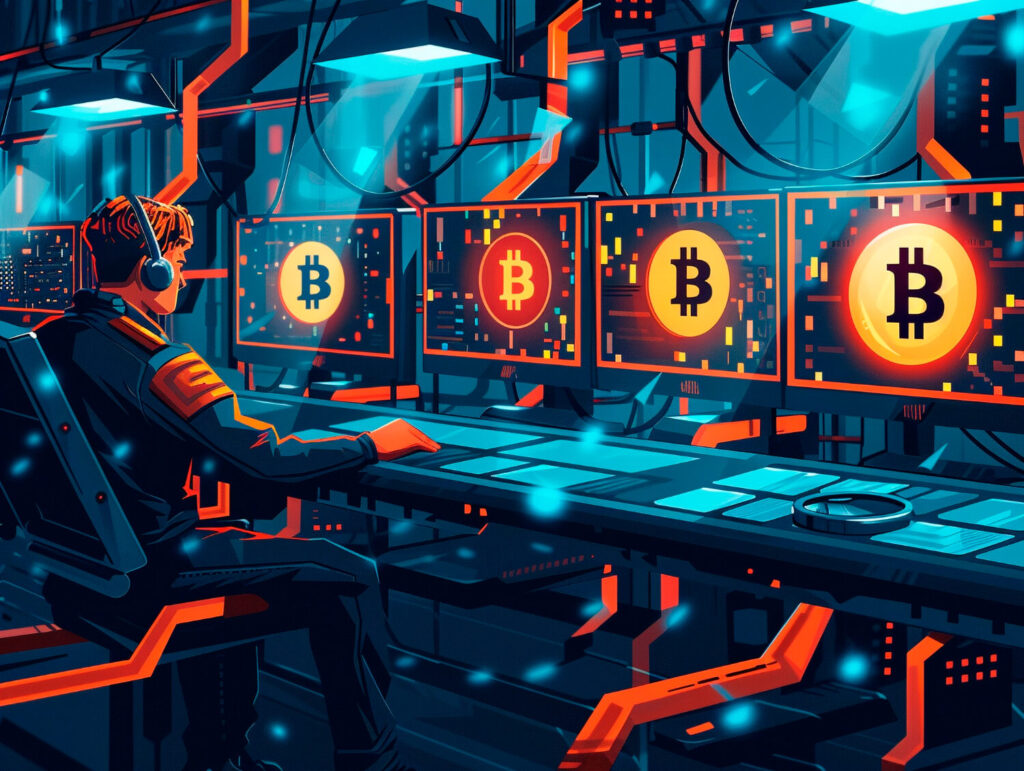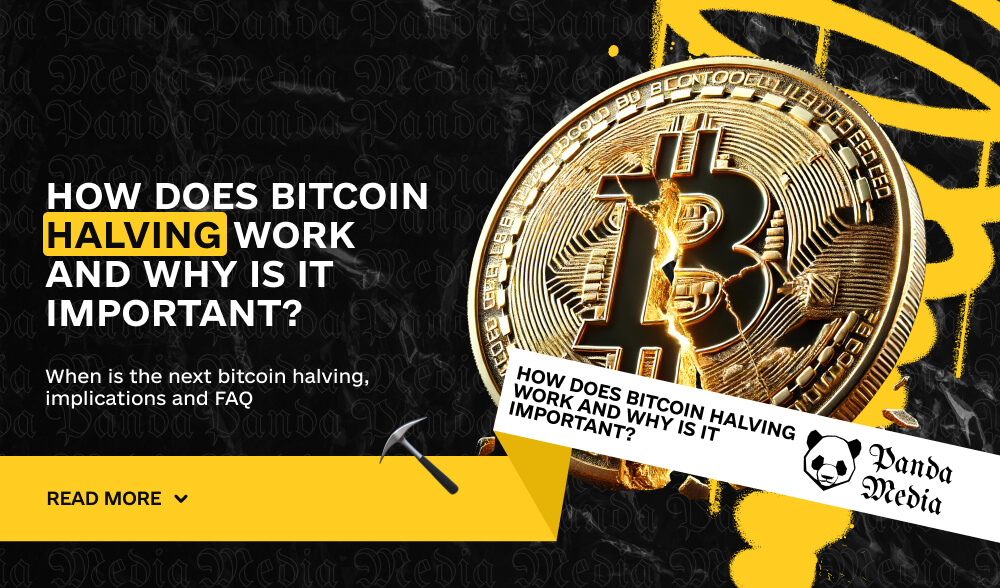Bitcoin is not just a digital currency, but a real revolution in the world of finance and technology. One of the most important events in its life is halving. This is a process during which the reward for mining Bitcoin is halved, and it occurs about once every four years. Halving has a profound effect on the Bitcoin economy, affecting its scarcity, inflation, and even its price. In this article, we will take a closer look at what halving is, how it works, and why it is so important for all cryptocurrency market participants.
Basics of the Bitcoin network: how the BTC blockchain works

To understand what halving is, it is important to understand the basics of the Bitcoin network. Bitcoin transactions are grouped into blocks that are protected by the mining process.
- Miners use powerful computers to solve complex math problems, and the first one to solve the problem adds a new block to the blockchain, receiving a reward in bitcoins. This reward per block for mining is a key incentive for miners who ensure the security and stability of the network.
- Bitcoin halving is an event that occurs approximately every four years and reduces the reward per block for mining by 50%. It is important to understand that halving has a significant impact on the Bitcoin economy, including its scarcity and the price of BTC. After halving, the number of new bitcoins entering circulation decreases, which creates a shortage and potentially increases the price of BTC.
- Bitcoin halving in 2024 will be the next step in the process of reducing the number of new bitcoins entering circulation. This event will take place approximately every four years, providing a stable mechanism to control bitcoin scarcity and inflation. The decrease in the reward per block affects the motivation of miners and the overall market dynamics, which makes understanding Bitcoin halving important for anyone interested in cryptocurrencies.
As a result, bitcoin halving and how it affects the price of BTC are important aspects of understanding the economics of this cryptocurrency. After halving, each new event affects the market, creating new challenges and opportunities for investors and miners. It is important to monitor changes in the network and analyze their impact on the cryptocurrency market.
Will there be a next Bitcoin halving in 2028?
The next Bitcoin halving is scheduled for mid-March 2028. This event will again reduce the mining reward, this time to 1.5625 BTC per block. Halving is an important event for the bitcoin community as it affects the cryptocurrency’s economy by reducing the number of new bitcoins entering circulation.
The exact dates of the halving will be known closer to the event, depending on the speed of block mining. The cryptocurrency community will be closely monitoring this event, expecting a possible impact on the market. Historically, halving has led to an increase in the price of bitcoin, as scarcity increases demand.
The upcoming halving in 2028 may once again attract the attention of investors and traders, creating new opportunities for the market. This event will emphasize the importance of Bitcoin as a decentralized digital asset with a limited supply, which makes it attractive for long-term investment.
Why is Bitcoin halving?

Scarcity
Bitcoin halving creates scarcity by limiting the total number of bitcoins to 21 million. This is similar to the scarcity of precious metals such as gold, making bitcoin more valuable over time. After a halving, when the reward per block decreases, the rate of new Bitcoin creation slows down.
This means that mining each new bitcoin becomes more difficult and resource-intensive. In 2024, bitcoin halving will further reduce the number of new bitcoins created, which increases the scarcity of the cryptocurrency and potentially increases its price. Bitcoin halving and how it affects scarcity is a key factor for long-term investors.
Inflation control
Halving helps control inflation. Unlike fiat currencies, which suffer from inflation due to central bank policies, bitcoin is becoming increasingly scarce, making it less susceptible to inflation. In a traditional economy, central banks can increase the money supply, which often leads to inflation.
Bitcoin, on the other hand, has a fixed maximum supply, and halving reduces the rate of its creation. This limits the growth of the Bitcoin money supply, ensuring its resistance to inflationary processes. In 2024, bitcoin halving will again help control inflation in the bitcoin ecosystem, making it a more stable asset.
Market forces
Decreasing rewards forces miners to work more efficiently or leave the network, which can affect its security and stability. After Bitcoin halved, miners received less reward for each block mined, which forced them to look for ways to increase their efficiency.
This may include upgrading equipment, joining mining pools, or even exiting the market for less efficient miners. Investor interest in halving events can also increase demand for bitcoin, affecting its price. When the next bitcoin halving event takes place in 2024, we can expect new changes in miner behavior and market dynamics, which will affect the price of BTC.
History of the Bitcoin mining reward reduction
- Halving 2012:
On November 28, 2012, the first halving reduced the mining reward from 50 to 25 BTC, which led to a significant increase in the price of Bitcoin over the next year. The last three halves took place in 2012, 2016, and 2020, resulting in a gradual decline in mining rewards. The first bitcoin halving took place in 2012 when the reward for mining a block was reduced from 50 BTC to 25 BTC. The main purpose of bitcoin halving is to manage the shortage and regulate the inflationary supply of bitcoins. This mechanism was built into the code by the founder of Bitcoin under the pseudonym Satoshi Nakamoto. - Halving 2016:
On July 9, 2016, the second halving took place. This event reduced the reward for mining a new block from 25 BTC to 12.5 BTC. After that, the value of Bitcoin rose sharply, peaking at $20,000 in late 2017. This was a significant jump in price that attracted a lot of attention from both individual investors and institutional investors. However, after this surge, the price fell to $3,500 in 2018. This volatility demonstrated how bitcoin halving can affect market prices and investor interest. - Halving 2020:
In May 2020, the third bitcoin halving took place, reducing the reward for mining a new block to 6.25 BTC. This event coincided with increased interest from institutional investors such as large financial companies and investment funds. As a result, the price of Bitcoin has increased significantly, reaching a high of $61,000 in 2021. This growth was due to a combination of a shortage of new bitcoins on the market and increased demand from large players. This result showed how bitcoin halving can stimulate price growth and increase interest in cryptocurrencies. - Halving in 2024:
On April 20, 2024, the fourth bitcoin halving took place, reducing the reward for mining a new block to 3,125 BTC. In 2024, this event marked another important moment in the history of Bitcoin. We are currently witnessing the consequences of this event, including the record price of Bitcoin in early March 2024, which reached $73,750. This is a new historical high for the cryptocurrency, which emphasizes the importance of halving in the context of market dynamics and investor interest. Like previous halving events, this one also had a significant impact on market prices and market participants’ behavior. In addition, this event attracted a lot of attention from both individual investors and institutional investors, which further increased the demand for Bitcoin.
Consequences of halving

Halving affects the behavior of miners by reducing their profits. This forces them to look for more efficient hardware or join mining pools to stay competitive. Reduced rewards can lead to the consolidation of mining power, potentially affecting the decentralization of the Bitcoin network.
The main consequences of halving:
- Decrease in miners’ profits: miners have to look for more efficient equipment, and joining mining pools becomes a necessity to remain competitive.
- Consolidation of mining power: A decrease in rewards can lead to the concentration of mining power in large players, potentially affecting the decentralization of the Bitcoin network.
- Impact on the dynamics of supply and demand: a smaller number of new bitcoins creates a shortage in the market, which leads to an increase in demand and higher prices.
- Bull market: Investors expect an increase in the value of the asset, which leads to higher prices, and halving stimulates long-term growth in the market value of bitcoin.
- Attraction of media and investor attention: The halving event attracts attention, which further stimulates the demand for bitcoin and interest from the media and investors can increase the overall value of bitcoin.
Thus, each halving has a significant and lasting impact on the Bitcoin ecosystem, determining its market conditions and overall value as an asset.
Why is halving important? Editor’s opinion
I believe that Bitcoin’s halving is a key event for the first cryptocurrency, helping to maintain its scarcity and control inflation by influencing market forces. Each halving significantly reduces the number of new bitcoins, making them more scarce and, consequently, increasing their value, just like gold. It also makes bitcoin resistant to inflation and attractive to investors. Reducing the mining reward encourages miners to work more efficiently, positively affecting the security of the network. The interest in halving that was observed in November 2012 increased the demand for bitcoin and led to an increase in its price. This mechanism emphasizes the importance of Bitcoin as a decentralized digital asset.
In addition, with each bitcoin halving, its value is expected to increase. A halving, which occurs every 210,000 blocks, is an event when the reward to miners for mining new blocks is halved. The next halving is expected to happen in 2024, and it will further strengthen the scarcity and stability of Bitcoin in the market.
FAQ
Halving means “to divide in half”. Bitcoin halving is a key event that occurs about once every four years, reducing the reward to miners for confirming transactions and ensuring network security by 50%. Bitcoin halving is one of the events that affects the price of BTC. The first halving took place on November 28, 2012, the second halving on July 9, 2016, and the third halving on May 11, 2020. The next bitcoin halving is expected in April 2024. The halving occurs every 210,000 blocks and affects scarcity, inflation, and the price of Bitcoin.
Bitcoin halving occurs to reduce the reward to miners by creating scarcity and controlling inflation. This process helps maintain the stability and value of Bitcoin in the market.
Yes, a bitcoin halving occurs approximately every 210,000 blocks, which is equivalent to about four years.
The last bitcoin halving occurred on April 20, 2024, reducing the reward per block to 3,125 BTC.
To prepare for bitcoin halving, follow the news, assess market conditions, and adapt your investment strategies to the predicted changes.
The answer to this question depends on your point of view. Halving contributes to the scarcity and stability of bitcoin, which can be positive for long-term investors. However, reducing rewards can make it difficult for miners to work.
Historically, halving events have led to an increase in the price of bitcoin. The scarcity created by halving increases the demand for bitcoin, which can increase its price.
Yes, halving can affect the security of the network, as reduced rewards can force some miners to leave the network, potentially reducing overall mining power and decentralization.
Halving will continue until all 21 million bitcoins are mined. According to the current schedule, the last halving will take place around 2140.
Halving reduces mining rewards, which can reduce miners’ profitability. This forces miners to look for more efficient equipment and join mining pools to maintain profitability.
Yes, the mining difficulty is automatically adjusted every two weeks depending on the total mining capacity of the network to maintain a stable block-finding time.
Halving often attracts investors’ attention and increases demand for bitcoin, which can increase its price. Investors can use halving as an opportunity for long-term investment.
While historical data shows that halving leads to price increases, market conditions can change. Predicting the exact impact of the next halving is difficult, but in general, demand and prices are expected to increase.



